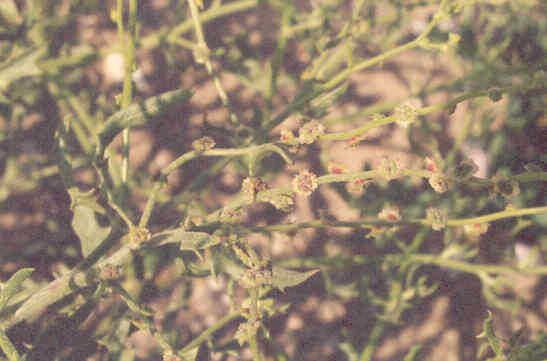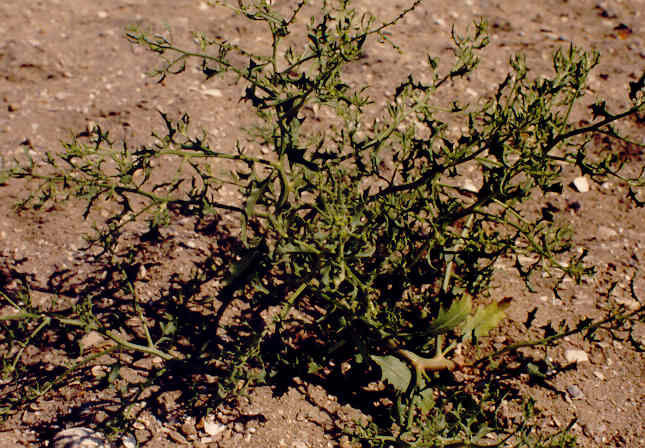
Cycloloma atriplicifolium (Sprengle) J. Coulter
Chenopodiaceae (Goosefoot Family)
Central North America
 |
Cycloloma atriplicifolium (Sprengle) J. CoulterChenopodiaceae (Goosefoot Family)Central North America
Winged Pigweed |
August Photo
Plant Characteristics:
Erect or spreading branched annual, 1-5 dm. tall, villous tomentose in
younger parts; lvs. alternate, petioled, oblong in outline, coarsely
sinuate-dentate, early deciduous, 2-6 (-8) cm. long, petiole 0-12 mm.; infl. a
broad panicle, fls. small, bracteate, solitary or in glomerules; calyx 5-lobed,
the lobes inflexed, strongly carinate, 3-4 mm. broad, villous, reddish in age,
the basal tube in age developing a broad membranous wing; pericarp
membranaceous, free from the seed, tomentulose; stamens 5, stigmas 3, seed
horizontal, smooth, black, 1.5 mm. in diam.; embryo annular.
Habitat:
Occasional weed in sandy fields and groves below 800 m., s. Calif.; to
Man., Ind. Texas.
May-Sept.
Name:
Greek, cyclos, a circle, and loma,
referring to the calyx-wing. (Munz,
Flora So. Calif.
365). Latin, atriplex,
a plant genus and Latin, folium, a
leaf. (Jaeger 31,104). Atriplicifolium,
leaves like Atriplex.
General:
Rare in the study area with only two plants known to have been found
through 1996. The first by Karlin
Marsh in 1984 on the small mound of dredged sand about one-quarter mile
northerly of the intersection of Back Bay Dr. and San Joaquin Hill Rd. The newest specimen is from the newly created dunes behind
the Fish and Game trailer at Shellmaker Id.
The sand in these dunes is partly old dredged material that has been
leached of its salts and partly material below this that was below the high tide
line and probably is at least alkaline from saltwater seepage at high tide.
Moving the material about 75 yards undoubtedly mixed it to some extent.
At present (summer of 1996) Heliotropium
curassavicum, has established itself sparsely over the entire dune area, no
other plants have sprouted except one Cycloloma
atriplicifolium, one Nemacaulis
denudata, and one palm species, probably Washingtonia robusta. One
soil sample has been tested by Pam De Vries, a botany student at Cal Poly
Pomona, and this shows no salts or nutrients at the test location. The
dune area contains approximately
12,000 square feet. (my comments).
One species in the genus. (Munz,
Flora So. Calif. 365).
Text Ref:
Abrams, Vol. II 74; Hickman, Ed. 511; Munz, Flora
So. Calif. 365.
Photo Ref:
July-Sept 96 # 11,15.
Identity: by R. De Ruff,
confirmed by John Johnson.
Computer Ref: Plant Data 498.
Have plant specimen.
Last edit 12/10/02.
 |
August Photo